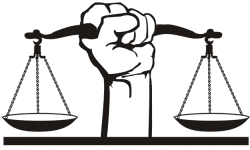Police
are much more likely to get involved in domestic disputes
than they were in the past. In many respects, this is a
welcome change. However, some officers have been poorly
trained and fail to use their common sense. As a result,
mistakes are made and even non-violent family quarrels
can result in arrests with high bail and potential
criminal charges.
Even if no injury occurs, the penalties against domestic
violence offenses are severe. In many counties, such
offenses will result in formal probation, a year of
mandatory counseling, and possibly jail. The standard
California jury instruction reads as follows:
Every
person who willfully [and unlawfully] uses any force or
violence upon the person of [his] [her] [spouse] [person
with whom the defendant is cohabiting] [person who is the
parent of the defendant's child] [former
spouse] [,] [fiancé] [,] [fiancée] [,] [an individual
with whom the defendant currently has, or has previously
had, a dating or engagement relationship] is guilty of a
violation of Penal Code section 243, subdivision (e)(1),
a misdemeanor.
["Dating relationship," as used in this
instruction, means frequent, intimate, associations
primarily characterized by the expectation of affection
or sexual involvement independent of financial
considerations.]
In order to prove this crime, each of the following
elements must be proved:
1. A person used force or violence upon [name of alleged
victim],
2. The use was willful [and unlawful]; and
3. At the time of the use of force or violence, [name of
alleged victim] was [[his] [her](required relationship)]
[an individual with whom the defendant currently has, or
has previously had a dating or engagement relationship].
(CALJIC 16.140.1)
If an injury occurs, an individual can be charged with a
felony and the penalties are typically more severe:
Every person who willfully inflicts upon [[his] [her]
spouse] [a person with whom [he] [she] is cohabiting]
[any person who is the [mother] [or] [father] of [his]
[her] child] corporal injury resulting in a traumatic
condition is guilty of a violation of Penal Code section
273.5, a crime.
"Corporal injury" means bodily injury.
A "traumatic condition" is a condition of the
body such as a wound or external or internal injury,
whether of a minor or serious nature, caused by a
physical force.
[Cohabiting" means unrelated persons living together
in a substantial relationship - one shown at least by
permanence and sexual or amorous intimacy. [Holding
oneself out to be the husband or wife of the person with
whom one is cohabiting is not required.]]
In order to prove this crime, each of the following
elements must be proved:
1. A person willfully inflicted bodily injury upon [[his]
[her] spouse] [another person with whom [he] [she] was
cohabiting] [any person who is the [mother] [or] [father]
of [his] [her] child]; and
2. The bodily injury resulted in a traumatic condition.
(CALJIC 9.35.01)
In recent years, it also has become more likely that the
state will become involved in situations involving
allegations of child abuse. Again, in this "domestic
violence" context, the discretion may be in the
hands of a law enforcement investigator who uses poor
judgment. As defined by a standard California jury
instruction, "child endangerment" is defined as
follows:
Every person who, under circumstances or conditions
likely to produce great bodily harm or death, [willfully
inflicts unjustifiable physical pain or mental suffering
on a child,] [or] [willfully causes or, as a result of
criminal negligence, permits a child to suffer
unjustifiable physical pain or mental suffering,] [or]
[has care or custody of a child and
[a] [willfully causes or, as a result of criminal
negligence, permits the child to be injured,] [or]
[b] [willfully causes, or, as a result of criminal
negligence, permits the child to be placed in a situation
where his or her person or health is endangered,]]
is guilty of a violation of Penal Code section 273a,
subdivision (a), a crime.
The word "willfully" as used in this
instruction, means "with knowledge of the
consequences" or "purposefully."
In the crime charged in the information, there must exist
a union or joint operation of act or conduct and either
general criminal intent or criminal negligence. (CALJIC
9.37)
Additionally, if the conduct is likely to case
"great bodily harm" or "death" the
matter may be charged as a felony with potentially severe
consequences. In this regard, the standard jury
instruction requires:
[1. A person who had care or custody of a child
[a.] [willfully caused or, as a result of criminal
negligence, permitted the child to be injured;] [or]
[b] [willfully caused or, as a result of criminal
negligence, permitted the child to be placed in a
situation where his or her person or health was
endangered;]] and
2. The person's conduct occurred under circumstances
likely to produce great bodily harm or
death. (CALJIC 9.37)
If you have been charged with domestic violence, you
should consult an experienced criminal defense attorney.
Probably the most common defense in a domestic violence
situation is self-defense. The standard jury instruction
in California describes self-defense (in non-homicide
situations) as follows:
It is lawful for a person who is being assaulted to
defend [himself] [herself] from attack if, as a
reasonable person, [he] [she] has grounds for believing
and does believe that bodily injury is about to be
inflicted upon [him] [her]. In doing so, that person may
use all force and means which [he] [she] believes to be
reasonably necessary and which would appear to a
reasonable person, in the same or similar circumstances,
to be necessary to prevent the injury which appears to be
imminent. (CALJIC 5.30)
|
|
Home
Representing the rights of
individuals throughout the Bay Area
Investigation
by Law Enforcement
General
Information about Criminal Charges
Driving
Under the Influence
All
Narcotics Offenses
Medical
Marijuana
Domestic Violence and Child
Endangerment
Resisting
Arrest / Free Speech
Serious
Felonies
State
and Federal Motions, Trials and Appeals
About Mr.
Feinland
Office
Locations
Send
Email
Our Cases in
the News
|

